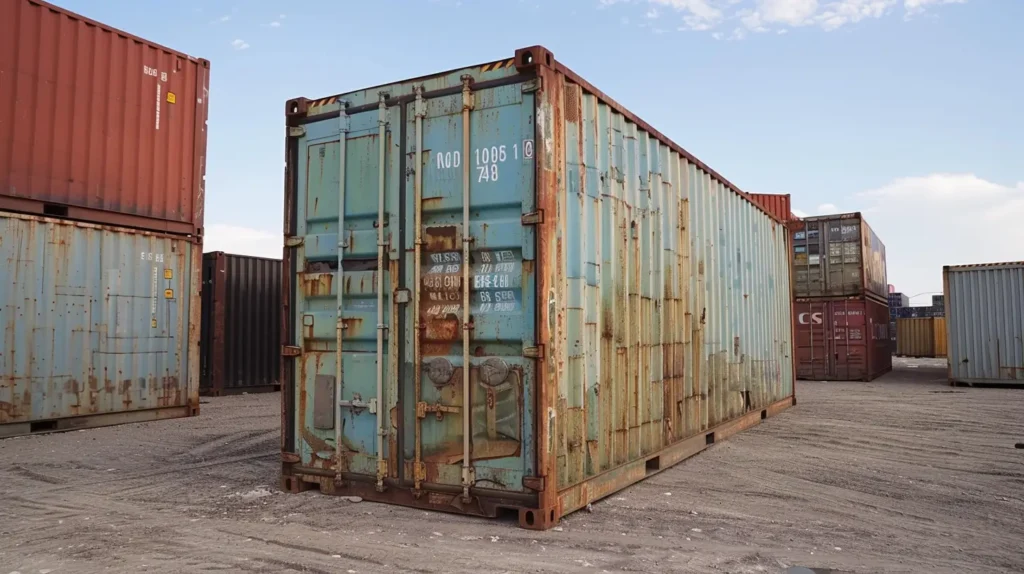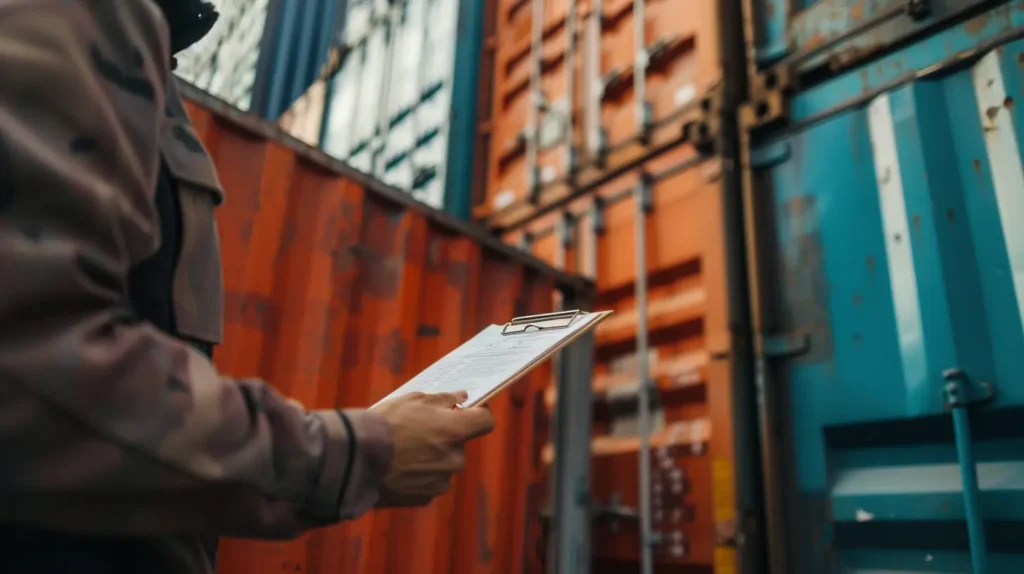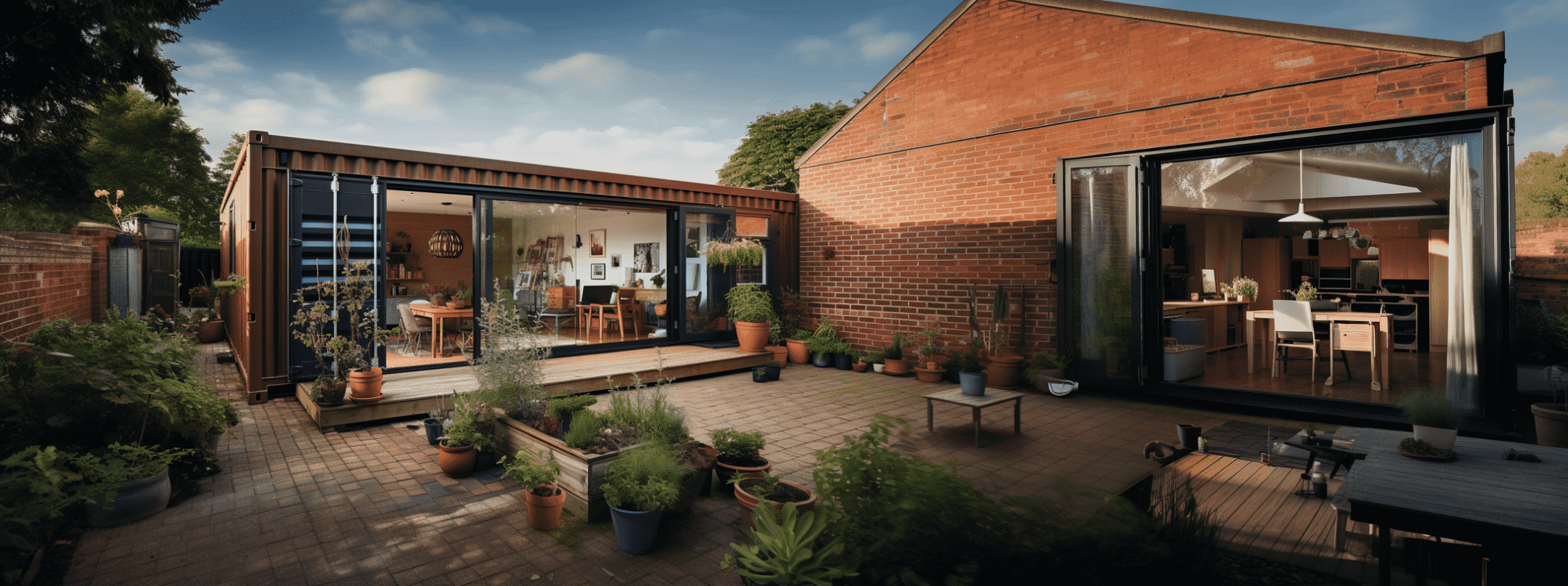Used shipping containers are in high demand, with the general shipping container market seeing steady growth over the last few years. Storage and conversion opportunities are driving this demand, with many people turning to used containers for a variety of projects.
But buying a used shipping container requires careful consideration of your needs. You need to ensure the container you buy is fit for purpose. Since no two used containers are the same, there are several factors to consider.
Why should you buy used shipping containers?
There are many reasons why buying used shipping containers is a great option. You probably already know some of the benefits, but understanding the reasons why used containers are a viable option for storage, transport, and modification can help you find the perfect one for your needs.
Affordability
Compared to traditional construction materials, shipping containers offer a cost-effective option for building structures. It’s often significantly cheaper to buy a used shipping container than invest in wood, brick, or steel for similar square footage. For small businesses, individuals, or startups seeking functional space without overspending, used containers are particularly appealing.
When it comes to buying used shipping containers for storage or workspace purposes, affordability is a major advantage. The affordability element doesn’t just stop at the initial purchase, either; you can also save on construction time, labour, and maintenance.
Durability
If you require durable storage or a workspace solution, refurbished or used containers are an ideal option. Made from steel and designed to withstand harsh weather conditions during transit, these units are robust and long-lasting. Naturally, they are also resistant to rust and corrosion.
Although used shipping containers may have already had a long life at sea, their durability makes them a practical choice for land-based use. With proper maintenance and refurbishment, they can provide decades of use in their new lifeform.
Interested in learning more about how long shipping containers can last?
They’re built to withstand harsh environments, but their lifespan can vary depending on how they’re used, stored and maintained.
Read our full guide on what affects their lifespan and how to keep yours in top condition for years to come.
Read guideVersatility
One of the reasons why used containers have become so popular in recent times is their incredible versatility. Essentially, shipping containers are large, modular steel boxes, which means they can be customised to meet a wide variety of needs. It’s possible to create container garden rooms , workspaces, storage units, pop-up shops, and more from used shipping containers.
Plus, the modular design of shipping containers makes modification and stacking a possibility. This means you can stack several containers side by side or on top of one another to create larger structures, and even add more units to your space over time.
Sustainability
When you buy a used shipping container, you’re not only getting a low-cost and practical solution, but you’re also reducing waste and making an eco-conscious choice. By choosing used, you can reduce the demand for new construction materials, saving energy, limiting resource extraction, and preventing unnecessary waste.
Instead of traditional construction methods that produce a lot of waste, repurposing a shipping container gives new life to an existing structure. Effectively, you’re contributing to a circular economy and extending the lifespan of durable units that would otherwise be destined for scrap. Pretty neat, hey?
Pros and cons of buying used shipping containers
Like buying any shipping container, there are pros and cons to buying a used unit, so it’s important to weigh them up before you make a decision.
Pros of buying used shipping containers
Used containers tend to be more affordable than new ones, making them ideal for budget-conscious buyers. No matter what you’re using them for, used units can keep upfront costs low without compromising durability and functionality.
And as we already mentioned, choosing used containers is a more sustainable practice, too, extending the lifecycle of a product that was built to last for decades. Additionally, used shipping containers can be modified and refurbished to suit your needs, whether it’s a simple but secure storage space, a temporary workshop, or a full-scale living space.
In essence, the key benefits of buying used shipping containers are:
- Affordability
- Sustainability
- Flexibility
Cons of buying used shipping containers
There are a couple of drawbacks to buying used shipping containers. Cosmetic wear and tear is commonly found, for example, rust, dents, or faded paint. These issues don’t always impact functionality, but they can definitely affect the appearance of your container. However, most of these problems can be rectified with a little maintenance and TLC.
Some used shipping containers may also have reduced structural integrity compared to new containers due to their long life as a transportation method. Heavy loads and exposure to harsh environments will contribute to this, so it’s a good idea to have a professional inspection before you buy.
While used containers are incredibly versatile, some modifications can be a little more challenging. For example, precise fittings, smooth interior walls, or straight edges may be harder to come by than in a new container.
Things to consider before buying used shipping containers

Weighing up the pros and cons of used shipping containers is one thing, but you also need to consider several other factors that could influence your purchasing decision. Knowing which container to buy and why is key.
You should keep an eye out for the following:
- Condition – Shipping containers will be graded based on their condition, ranging from new/one trip containers to as-is. Lower-graded containers may not have guarantees of structural soundness or weatherproofing, so be sure to assess your needs when considering container condition.
- Location – Determine where you’ll place the container and whether you need any permits for placement. Some locations may require planning permission, depending on what you’re using the container for. Also, make sure to choose clear, level, and hard-standing ground before delivery to ensure a seamless process.
- Budget – While shipping containers are cost-effective, additional costs such as delivery, customisation, and modification should be factored into your budget. For example, modifying your container to create a liveable space will be significantly more expensive than using a container as a shed for storage.
- Size – Make sure you choose a size that suits your purpose, considering the overall dimensions and interior space, especially if insulation and interior modifications are planned. It’s advisable to draw up some plans for containers in different sizes before you decide, as the cost difference may be small.
- Supplier – Research reputable suppliers in your area or beyond to ensure they provide quality containers and offer suitable delivery options. Always read reviews too – with high demand for shipping containers, it can be easy to choose the fastest and cheapest container, but it may not be from the best supplier.
- Inspection – If possible, inspect the container in person or request detailed photos to assess its condition. Most reputable suppliers will allow you to inspect the container yourself or provide guarantees for the condition.
Looking beyond just used containers?
Used containers are just one part of the picture — there’s a lot to consider when buying, and it’s worth knowing what other options and factors are out there before making a decision.
Check out our full shipping container buying guide for expert advice on choosing the right container for your needs.
Read guideHow much is a used shipping container?
Used shipping containers can range anywhere between £700 and £4,000. However, the price you’ll pay for a used container depends on the condition and how it’s graded. Containers in better condition will cost more than those that have had many trips at sea or have some structural issues.
The good news is that prices for containers are falling globally, simply due to basic economics. There are many more containers currently available, and this is what lowers their prices.
How to prepare before buying a used container
Buying a used shipping container isn’t as simple as walking into a dealership, choosing a unit, and driving away with a product. Our step-by-step approach to buying used containers can help you get the right unit for your needs without unnecessary hassle.
Research
Your first step is to gather information about various types of containers, their sizes, and local suppliers that can readily source used shipping containers for you. Make sure you read reviews and ask other people who have bought containers for recommendations and experiences. If a supplier isn’t local to you, you could also ask for photos and serial numbers to help your research.
Contact suppliers
Many suppliers buy used shipping containers and have plenty in stock. They may also have contacts for more bespoke requests. Talk to potential suppliers and ask them if they can supply the type of container you’re looking for, what their prices are, and the delivery process. This is also a good opportunity to ask about container grades and what they have available, and whether they can carry out customisations.
Ask questions
Ask for information about the state of the repurposed shipping container, its history, any adaptations it may have undergone, as well as the supplier’s return guidelines. This is a key step in ensuring you purchase a used container that meets all your requirements.
Inspect the container
If and when possible, go to the supplier’s site to check the container in person. Check for evidence of rust, dents, and structural soundness. Some suppliers might offer an additional inspection service for peace of mind, with guarantees or warranties to supplement your purchase.
Discuss modifications
If you want to alter or modify a used container, it’s best to discuss your needs with your supplier. Some provide customisation options and conversions before delivery, which help you save valuable time and effort.
Need a custom container conversion?
We design and build everything from container homes, workshops and offices to retail units and more – all customised to suit your space and purpose.
Take a look at our container conversions and see what’s possible today.
Explore ConversionsGet a quote
Once you are comfortable and satisfied with a container, ask for a breakdown quote that gives you shipping costs, freight costs, and any additional services. Look out for hidden costs that you may not have factored into your budget.
Review the agreement
Before confirming, carefully read the sales agreement or contract. You should ensure that all terms, conditions, and costs are made clear. If you see anything that is unclear or has not been previously discussed with your supplier, ask about it and, if necessary, have the agreement amended.
8 questions to ask when buying a used shipping container
If you’ve considered your options and have narrowed down your search, there are several questions you should ask your supplier before you sign on the dotted line.
1. What size shipping container do I need?
Shipping container size is a primary consideration and will impact what you can do with your available space. 10ft, 20ft, and 40ft are the most common lengths. To help you decide, think about the following when choosing a container:
- 20ft and 40ft containers generally provide the best value and availability.
- 10ft containers can be more expensive due to many of them being cut down from larger sizes.
- 40ft containers offer double the space of 20ft, but require more room for placement and delivery.
- Standard containers are 8.5ft tall internally, while high-cube options add an extra foot of headroom.
Whatever size you choose, always ensure sufficient site space and access for delivery, and visualise the container’s footprint beforehand. You could incur additional costs if the supplier is unable to deliver to your site or has difficulty accessing it due to foreseeable issues.
2. Is the container structurally sound and weatherproof?
Assessing the condition is crucial when buying a shipping container. Used shipping containers are inherently airtight, watertight, and durable, but may have signs of wear and tear that are invisible to the untrained eye. Cosmetic damage is common in used containers but usually doesn’t impact functionality.
It’s important to ask your supplier what condition the container is in, particularly in relation to water tightness and structural integrity. You don’t want to buy a container, customise it, and then find out you have leaks or warping sides. To ensure the container is watertight, specifically ask about the condition of the door seals; these are what prevent water ingress, and they should be fully intact with no gaps.
You should check that the original container doors are ‘free and easy’ – used containers have a reputation for having stiff or difficult-to-open doors, which can be problematic later on. When inspecting the container, make sure the doors are easy to open and close, and also close securely. You should check the hinges and make sure they are free of rust, as this can impact the door functionality.
Flooring is also key. You’ll want to check the flooring of the unit is still structurally sound and intact. You can do this visually yourself, but it’s worth getting an expert to check for signs of rot or rust in places that may be difficult to spot.
3. Can the shipping container be delivered to my site (and what will the delivery cost be)?
Container delivery requires specialist transport due to their significant weight – around 2.2 tonnes for 20ft containers and over 3.5 tonnes for 40ft units. When speaking with your supplier, confirm delivery to your location and obtain a clear, VAT-inclusive quote from the supplier.
Your supplier will be able to tell you how container delivery works. However, delivery is typically completed via HIAB or tilt-bed trucks, requiring sufficient site access, level ground, and clearance from obstructions. HIABs offer precise placement, while tilt-beds need ample space for unloading. Suppliers may need site photos or measurements beforehand, and on-site direction for the driver is recommended.
Always plan delivery carefully to make sure efficiency and unexpected costs. If you can, over-plan for delivery and be extra cautious – better safe than sorry!
4. Can the container be customised or upgraded to suit my needs?
Many shipping container suppliers offer customisation and modification for used shipping containers, which could be worth exploring if you’re looking for something unique.
You may want to ask about:
- Security upgrades – Lock boxes (steel cowls around the padlock), for example, deter theft and are essential for many use cases. Ask if one can be fitted if it’s not already included.
- Repainting – A fresh coat of paint in a colour of your choosing can improve aesthetics and add protection, whether it’s to complement your site surroundings or display branding.
- Ventilation – For moisture-sensitive items, vents or moisture traps help prevent condensation inside the container. A simple plywood lining can also help avoid this.
- Shelving – Bolt-in racking systems improve organisation and make better use of space. There are also plenty of other options you can ask about when it comes to shelving and storage solutions.
- Electrics and insulation – For workshops or site offices, ask about fitting lights, sockets, insulation, heating, and windows. These can often be pre-installed before delivery or on-site, so you have flexibility in how your container is fitted out.
Most of these customisations are more affordable and efficient when done before delivery, but you’ll usually have a choice. Be aware that some companies handle modifications internally, while others outsource, which could increase your costs. It’s important to verify available options and obtain a quote for a ready-to-use container.
5. What maintenance will my used shipping container require?
Ask your supplier what the maintenance will be like on your chosen container. They should be able to advise you on the container maintenance process, which often includes:
- Regular inspections – Check for dents, damage, and debris on the roof. Clear off leaves or standing water to prevent rust, and inspect rubber door seals.
- Rust treatment – Surface rust is common and not a major issue if caught early. Wire brush any exposed steel and apply specialist primer and paint, especially on door edges.
- Hinge lubrication – Apply grease or oil to hinges and locking rods yearly, especially in damp or cold weather, to keep doors operating smoothly.
- Moisture control – Use desiccant packs, damp sticks, or vents to reduce condensation, and avoid storing damp items. You can also open the doors occasionally to increase airflow and prevent moisture building up.
- Foundations – Place the container on level, solid ground or support at the corners to prevent twisting and ensure the doors stay aligned. Regularly check that your foundations haven’t shifted too.
6. Can I inspect the container before purchase (or see photos)?
If you can, you should always inspect the container before you purchase it. Verification of the container and its condition will build trust for both you and the supplier. It helps to make sure you are satisfied with the unit before payment, avoiding a container arriving that doesn’t meet your expectations.
Reputable sellers like Universal Containers will often provide detailed photos, videos, or depot visits for inspection. If you’re in contact with a supplier who refuses to show the actual unit and is only sending generic images, it might be best to avoid them.
7. Will my used shipping container be secure?
Shipping containers are secure, but there are other ways to make them even more secure, such as lock boxes which enhance theft deterrence. Depending on your use case and location, this could be a non-negotiable addition.
There are also many other ways you can secure a shipping container yourself, from CCTV and motion lighting to additional locks and fencing.
8. Is the shipping container certified?
If you’re using a shipping container for transport, your container should meet certification standards for overseas shipping. A valid CSC plate is essential for international transport. This certifies that a container meets international safety standards for shipping and includes its ID, manufacture date, and inspection date, proving the container is structurally sound.
Missing, damaged, or expired plates will require reinspection and recertification for shipping, and shipping lines are likely to reject uncertified containers. Even if you’re not planning to ship, a CSC plate indicates prior cargo-worthiness and build quality, aiding its resale and giving you comfort in the condition of your unit.
💡Pro tip: Always inspect the CSC plate for age, serial number, and safety compliance during container checks. To help track and verify the certification details, you could photograph the plate for your records.
Inspecting a used shipping container before purchase

Once you’ve sought answers from your supplier, you should actively inspect the unit before you buy a used shipping container. You can do this yourself or enlist the help of a professional who knows what they are looking for.
A thorough inspection is a key part of the buying process to help you avoid potential issues, assess suitability for your project, and get good value for money.
Checklist for inspecting used shipping containers
- Inspect the container’s exterior for significant dents, scratches, or impact damage.
- Surface rust is generally acceptable, but structural rust, especially at corners and edges, is concerning.
- Thoroughly examine the roof for dents that could collect water and cause corrosion.
- Avoid containers with deep or pooling areas on the roof unless you plan for repairs.
- Ensure doors open and close smoothly without excessive force, as stiffness or misalignment could indicate potential damage.
- Inspect rubber door seals for integrity, flexibility, and absence of cracks or wear.
- Inspect the inside of the container for leaks, water damage, and daylight showing through the walls or the ceiling.
- Check the flooring for soft spots, staining, or rot.
- Avoid containers with strong chemical or fuel odours, and request a use history if odours are present. Consider alternative containers if the use history is unavailable, especially for conversion or sensitive storage.
- You should also check underneath the container for signs of rust, damage, or other structural issues.
Shipping container grades
Shipping containers, whether new or used, are graded to help buyers establish the condition of their unit. Suppliers use letter-based grading systems to indicate container condition, commonly ranging from Grade A to Grade D.
These grades are not standardised but offer a general assessment when evaluating containers:
- Grade A: This is the best condition you’ll find, indicating it might be new or a one-trip container. This grade indicates the unit is structurally sound, wind and watertight, with only minor cosmetic wear (like surface rust or light dents).
- Grade B: Still secure and watertight, but with more visible wear and tear — think faded paint, heavier rust, or internal blemishes. These units are often used for straightforward storage, where appearance isn’t a priority.
- Grade C: These containers may show significant signs of wear, including more extensive rust, floor damage, or large dents. They are not suitable for shipping, but can work for low-cost, non-critical storage.
- Grade D: With this grade, the unit is typically very worn out. Expect visible damage, corrosion, and/or missing parts. These are often best avoided unless you’re open to making extensive repairs or need something very temporary.
The bottom line
When buying a used shipping container, there is a lot to think about, but that shouldn’t put you off. Used shipping containers offer an excellent solution for many container projects, as long as you choose the right one.
Our guide should have given you a good starting point for researching and buying a used shipping container, but if you need more advice or guidance, our friendly team is always on hand to support you in your buying journey.





